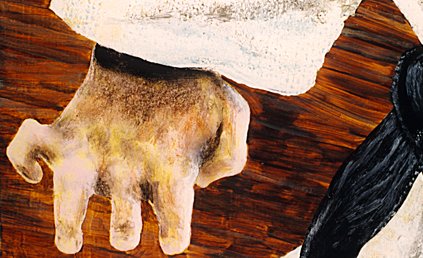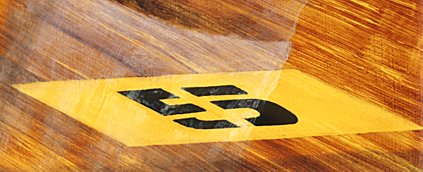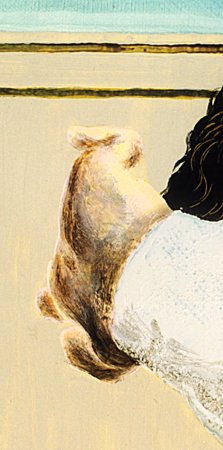|
|

|
FIVE © 1996 Keith Halonen oil on panel 12×72¼ in / 30×184 cm $ 9,500 US Karate (Japanese: kara = empty, te = hand) is a learned form of intense unarmed physical combat. This painting features a black belt performing traditional Japanese kata during a promotional examination. The student's dan (rank) signifies a level of learning and applied achievement. Each student is required to perform rigorous basic martial exercises including dance-like kata, which embody elaborate sequences of combat situations symbolizing assault by multiple attackers. Such ritualized performances are not intended to realistically represent the unpredictable situations encountered in a genuine attack. Effectiveness does not come naturally. The idea is to assimilate many attack scenarios through constant repetitive practice. Karatekas (students) rehearse postures and movements until, by dint of repetition, these actions become part of the body's repertoire of autonomous resonses. In a critical situation, no conscious thought will take place in the defender's mind. Conscious deliberation might actually interfere with one's ability to ward off assault. |
|

|
« CLICK to contact the artist |








|
CLICK » to order this print |

|
|
YOU ARE IN THE PEOPLE PAINTINGS GALLERY
CLICK THE SHORTCUT ICONS ABOVE TO VIEW MORE PAINTINGS |
|
The hand position below is characteristic of the dynamically extreme and typically unnatural postures one expects to encounter in the practice of the martial arts. The tendons and surface extensor muscles of the forearm and back of the hand are drawn tense as possible. The simplest description of the action is that one is attempting to touch the outer forearm with the knuckles of the same hand by pulling them back until they are virtually cramped.
|
 
|

|
|
|
Detail from FIVE
|
|
The proximal phalanges are pulled up and back as the distal ends of the metacarpals are forcibly pushed outward, as if to splay open the palm. The thumb is cocked to add more tension to the "heel" of the palm. The whole effect is to cause the flexor and opponens palm muscles to be as rigid as possible. In this fashion they become a club-like striking surface, effective against large organs and soft tissue. As the upper hand tugs at sleeve or wrist to yank the opponent off balance and forward into the technique, the opposite hand sweeps down in an arc to impact the opponent's diaphragm or groin.
While this may seem to be grossly repulsive, the student of fighting approaches the learning process with the same impartiality that the medical student brings to an autopsy. The difference is a matter of emotion. Emotion is what distinguishes martial science from martial art. While it behooves a surgeon to maintain strict objectivity during the application of his science, such calculated control is denied to the victim of physical assault. The martial artist who is already under attack must rally all senses while under extreme pressure, harness the adrenaline and anger intrinsic to the situation, and rechannel all these negative components into a defensive response. This is far more an art than a science. |









|